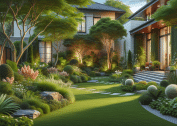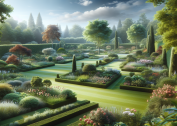Curious about turning your small backyard into a more vibrant, enjoyable space? Discover practical landscaping ideas, gardening tips, and design strategies that help maximize yard potential without major renovations. Embrace smarter layouts, vertical gardening, and functional outdoor features to make every square foot count.
Backyard Layouts That Make Space Work for You
Small yard design can feel limiting, but creative layouts open up new possibilities. By focusing on clear pathways, efficient zones, and visual depth, it’s easier to make a confined area feel inviting. Raised garden beds, curved stone paths, and integrated seating can define different areas for dining, relaxing, and play. A functional layout considers how sunlight travels across the yard and how smaller spaces benefit from strategic planting and multifunctional features. These thoughtful approaches help turn even miniature gardens into peaceful retreats.
One of the main strategies embraced by landscaping experts is to introduce structure using low-cost, high-impact elements. For instance, adding a small patio or gravel seating area gives a focal point—making the whole space flow. Edging materials such as bricks or pavers neatly divide planting beds from walking paths, keeping things tidy and easy to maintain. Open, permeable surfaces like stone chips can enhance drainage and reduce muddy patches. It’s not about having more space but making better use of what exists.
Designing small backyards for maximum usability often relies on careful selection of furniture and accessories. Folding tables, stackable chairs, and built-in benches work well for smaller spaces. Layering plants by height or color can create an illusion of abundance, making the area feel more lush. Using light-colored paving or mirrors helps bounce daylight around, while narrow planters and suspended lanterns add vertical interest without overwhelming the ground area. All these design tweaks contribute to a feeling of openness even in the most compact gardens.
Gardening Tips for Small Spaces With Big Impact
Learning how to garden effectively in narrow or confined sites is all about adapting techniques and choosing the right plants. Compact shrubs, dwarf trees, and trailing vines are perfect for restricting root spread and keeping growth in check. Raised planters or container gardens promote healthy root development and make soil management more straightforward. Smart soil amendment goes a long way—adding compost supports moisture retention and nutrients, so even a tiny garden bed can thrive with less water and fertilization.
Vertical gardening is one of the most powerful approaches for small yards. Wall-mounted planters, trellises, and vertical palettes provide growing space upward rather than outward. This technique also lets you move herbs, flowers, and edibles above ground level, freeing up valuable terrace or grass surfaces. Hanging baskets and tower gardens provide variety and color at different eye levels, creating lush, layered visual appeal. Selecting shade-tolerant plants also ensures corners with less direct sunlight become green and lively.
Maximizing blooms and greenery often requires creative plant groupings. For instance, clustering pots in odd-numbered patterns draws the eye, while mixing fragrant species such as lavender or mint near seating makes outdoor living more enjoyable. Integrated irrigation, like drip systems or soaker hoses, leverages water usage efficiently, keeping plants healthy without waste. Small, tailored beds (rather than sprawling lawns) keep upkeep manageable and let you enjoy more flowers, vegetables, or greenery in less time each week.
Incorporate Functional Features Effortlessly
Small backyard bliss often starts with adding practical upgrades that elevate your lifestyle. Outdoor lighting, for example, extends the enjoyment of your garden well after sunset. String lights, solar path markers, and motion-activated LED spots increase both ambiance and safety. Even modest fire pits or chimineas create cozy gathering spots for quiet evenings. Modular raised beds or seating arrangements can be reconfigured for entertaining or relaxation, ensuring the yard suits multiple occasions and seasons. These enhancements boost value without a full renovation.
Outdoor storage solutions anchor tidiness and convenience. Slimline sheds, deck boxes, or custom-built benches with hidden compartments reduce clutter and free up floor space. Utilizing vertical storage—like wall racks for tools or hooks for garden hoses—also keeps even the smallest areas neat. Rain barrels or compact composters can be tucked into corners, supporting sustainability while keeping essentials close at hand. Every storage element should serve a dual purpose to truly optimize the limited space available.
Feature gardens, tiny ponds, or even container water features bring tranquility and a sense of luxury to ordinary yards. Setting up a small, bubbling fountain or bird bath adds movement and attracts wildlife, creating a mini-ecosystem right outside your door. Exploring multi-use furniture—such as extendable tables or flip-top benches—ensures that every item earns its place. With intentional selections, there’s room for entertaining, gardening, and relaxation all within one flexible landscape.
Choose Plants to Suit Your Space and Style
Plant selection plays a crucial role in the success of a small backyard transformation. Opting for compact, slow-growing species means less frequent pruning and a tidier appearance. Native and drought-tolerant varieties foster resilience, requiring fewer resources and less time commitment. Perennials save energy and budget by coming back yearly, while seasonal annuals allow for regular color changes. As a bonus, pollinator-friendly plants invite bees and butterflies, turning even tiny gardens into vibrant habitats for local wildlife.
Low maintenance doesn’t have to mean bland. Ornamental grasses, ferns, and succulents thrive with minimal care and offer exciting textures. Incorporating edible plants—think cherry tomatoes, strawberries, or herbs—in both containers and vertical planters makes the space productive and beautiful at once. Select shade-loving greens in areas with less sunlight, and sun-lovers for open patches. The variety supports thriving garden beds and keeps interest high across different parts of the year.
Color and structure go hand in hand. Cool-toned plants (like blue fescue or lavender) add calm, while fiery hues like red salvia or golden marigolds provide energy. Grouping by shape and texture, such as pairing bold-leaved hostas with fine-leaved ornamental grasses, offers visual appeal without overcrowding. Repeating patterns of plants helps direct attention and create a sense of unity throughout the small yard. It’s about building balance and personality around what the space naturally offers.
Design for Year-Round Enjoyment and Easy Care
Smart backyard design considers every season. Evergreen shrubs, winter-blooming perennials, and decorative mulches keep spaces appealing year-round. Planning for off-season maintenance—such as using hardy groundcovers or installing weather-resistant furnishings—ensures ongoing enjoyment. Choosing frost-proof pots or all-weather textiles helps reduce seasonal turnover, keeping things looking fresh with minimal effort. This thoughtful approach means there’s always something attractive and practical to enjoy, regardless of the month.
Simple maintenance strategies prevent chores from taking over. Automated watering systems, slow-release fertilizers, and weed-suppressing ground covers keep labor low while maximizing results. Using mulch to lock in moisture and disrupt weed growth protects plant roots and reduces water needs. Scheduling a quick weekly tidy—sweeping hard surfaces or pruning spent flowers—keeps small spaces lively and inviting with less input. The aim: a yard that stays neat without constant work.
Involving friends and family with easy, shared tasks—like planting seasonal bulbs, refreshing container displays, or harvesting homegrown herbs—fosters stronger connections to the outdoor space. Whether growing for food, hosting gatherings, or relaxing solo, the goal is always making the most of every square foot. Encouraging biodiversity, blending relaxation with productivity, and investing in user-friendly design forms the foundation of any successful small backyard sanctuary.
References
1. National Gardening Association. (n.d.). Smart Landscaping for Small Spaces. Retrieved from https://garden.org/learn/articles/view/4044/
2. University of Minnesota Extension. (n.d.). Gardening in Small Spaces. Retrieved from https://extension.umn.edu/how/yard-and-garden-small-space
3. Royal Horticultural Society. (n.d.). Ideas for Small Gardens. Retrieved from https://www.rhs.org.uk/garden-inspiration/small-gardens
4. American Society of Landscape Architects. (n.d.). Outdoor Living Trends. Retrieved from https://www.asla.org/outdoorlivingtrends.aspx
5. Green America. (n.d.). Sustainable Landscaping Tips. Retrieved from https://www.greenamerica.org/green-living/greener-lawn-gardening
6. Penn State Extension. (n.d.). Maximizing Small-Space Gardens. Retrieved from https://extension.psu.edu/designing-a-garden-for-small-spaces









